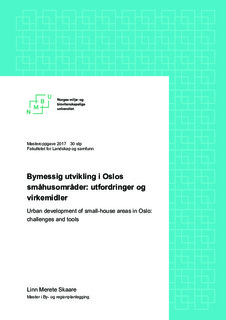| dc.contributor.advisor | Røsnes, August E. | |
| dc.contributor.author | Skaare, Linn Merete | |
| dc.coverage.spatial | Norway, Oslo, Grefsen | nb_NO |
| dc.date.accessioned | 2017-09-13T13:02:28Z | |
| dc.date.available | 2017-09-13T13:02:28Z | |
| dc.date.issued | 2017 | |
| dc.identifier.uri | http://hdl.handle.net/11250/2454552 | |
| dc.description.abstract | Oslo kommune har stor befolkningsvekst i vente, og vil dermed stå overfor utfordringer med økning av boligproduksjonen. Dersom utviklingen skal finne sted innenfor dagens byggesone, må store deler av utbyggingen skje gjennom fortetting av eksisterende boligområder og økt arealutnyttelse. Flere småhusområder ligger tett inntil Oslos indre by og er lavt utnyttet. Den kommende befolkningsveksten setter derfor ett stort utviklingspress på disse strøkene av byen, samtidig som fortetting i slike områder byr på utfordringer. Hvilke virkemidler kommunen tar i bruk i slike fortettingsområder kan derfor bli avgjørende for realisering av den ønskede utviklingen.
Denne masteroppgaven går nærmere inn på hvilke virkemidler kommunen har benyttet seg av i tilknytning til kommuneplanen 2015. Dette belyses gjennom prosessen som har foregått i utviklingsområdet på Grefsen. Nedre Grefsen er et eksisterende og velfungerende småhusområde som innen kommuneplanen 2015 ble utpekt til bymessig fortetting. For å oppnå en bymessig utvikling må eksisterende bebyggelse rives og eiendomsforholdene endres. Bomiljøet og den bystrukturelle stedsidentiteten som er der i dag vil slik sett bli omformet, ødelagt og således forsvinne.
Oppgaven tydeliggjør hvilke utfordringer som relaterer seg til fortetting i småhusområder og gir en oversikt over både lovpålagte og andre virkemidler som kan benyttes for å realisere kommunens fortettingsstrategi.
Studien viser at realisering av utbygging i småhusområder er avhengig av eksisterende grunneiers villighet til å gi fra seg sin eiendel. Hvordan planmyndighetenes formidling av informasjon til berørte eiere foregår på, hvordan de kommuniserer med dem under planleggingen og hvordan den evner å inkludere deres interesser og synspunkter både i sine planvedtak og i oppfølgingen av sin planlegging vil derfor bli avgjørende for planmyndighetenes evne til å realisere sine fortettingsstrategier. | nb_NO |
| dc.description.abstract | The municipality of Oslo aspect a large population growth, which will lead to challenges with an increased production of new households. If development is to take place within the current building zone, large parts of the development must take place through densification of existing residential areas and increased area utilization. Several small-house areas are located close to Oslo’s inner city and are poorly utilized. The upcoming population growth leaves a major development pressure on these areas of the city. At the same time densification in such areas presents challenges. Which tools the municipality choose to use will be essential for the realization of the desired development.
This master thesis focuses on which tools the municipality has used in relation to the municipal plan of 2015. This is highlighted by the process that has taken place in the developing area of Grefsen. «Nedre Grefsen» is an existing and well-functioning small district designated as an area of urban development within the municipal plan of 2015. To achieve urban development, existing buildings must be demolished and the property relation changed. The current living environment and the urban site identity will be transformed, destroyed and thus disappeared.
This thesis clarifies the challenges related to densi cation in small-house areas, and provides an overview of both statutory and other tools that may be used to realize the municipality’s densi cation strategy.
The study shows that the realization of development in residential areas is dependent on existing landowners’ willingness to give up their assets. How the dissemination of information by planning authorities to affected owners takes place, how they communicate with them during the planning and how they are able to include their interest and views both in their planning decisions and in the follow-up of their planning will therefore be decisive for the planning authorities’ ability to realize their densification strategies. | nb_NO |
| dc.language.iso | nob | nb_NO |
| dc.publisher | Norwegian University of Life Sciences, Ås | nb_NO |
| dc.rights | Attribution-NonCommercial-NoDerivatives 4.0 Internasjonal | * |
| dc.rights.uri | http://creativecommons.org/licenses/by-nc-nd/4.0/deed.no | * |
| dc.subject | Fortetting | nb_NO |
| dc.subject | Småhusområder | nb_NO |
| dc.title | Bymessig utvikling i Oslos småhusområder : utfordringer og virkemidler | nb_NO |
| dc.title.alternative | Urban development of small-house areas in Oslo : challenges and tools | nb_NO |
| dc.type | Master thesis | nb_NO |
| dc.description.version | submittedVersion | nb_NO |
| dc.subject.nsi | VDP::Social science: 200::Urbanism and physical planning: 230 | nb_NO |
| dc.source.pagenumber | 78 | nb_NO |
| dc.description.localcode | M-BYREG | nb_NO |

